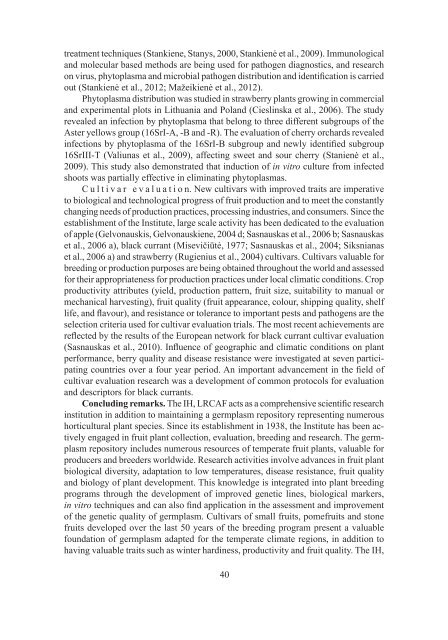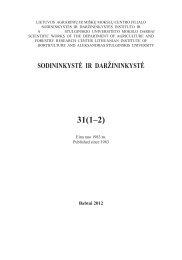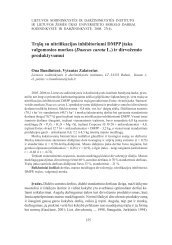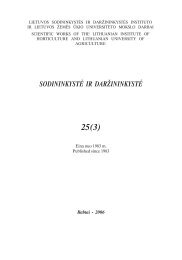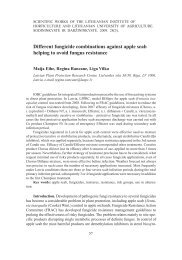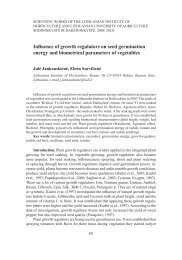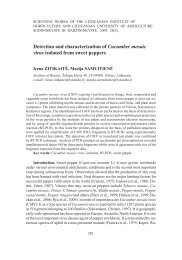treatment techniques (Stankiene, Stanys, 2000, Stankienė et al., 2009). Immunologicaland molecular based methods are being used for pathogen diagnostics, and researchon v<strong>ir</strong>us, phytoplasma and microbial pathogen distribution and identification is carriedout (Stankienė et al., 2012; Mažeikienė et al., 2012).Phytoplasma distribution was studied in strawberry plants growing in commercialand experimental plots in Lithuania and Poland (Cieslinska et al., 2006). The studyrevealed an infection by phytoplasma that belong to three different subgroups of theAster yellows group (16SrI-A, -B and -R). The evaluation of cherry orchards revealedinfections by phytoplasma of the 16SrI-B subgroup and newly identified subgroup16SrIII-T (Valiunas et al., 2009), affecting sweet and sour cherry (Stanienė et al.,2009). This study also demonstrated that induction of in vitro culture from infectedshoots was partially effective in eliminating phytoplasmas.C u l t i v a r e v a l u a t i o n. New cultivars with improved traits are imperativeto biological and technological progress of fruit production and to meet the constantlychanging needs of production practices, processing industries, and consumers. Since theestablishment of the Institute, large scale activity has been dedicated to the evaluationof apple (Gelvonauskis, Gelvonauskiene, 2004 d; Sasnauskas et al., 2006 b; Sasnauskaset al., 2006 a), black currant (Misevičiūtė, 1977; Sasnauskas et al., 2004; Siksnianaset al., 2006 a) and strawberry (Rugienius et al., 2004) cultivars. Cultivars valuable forbreeding or production purposes are being obtained throughout the world and assessedfor the<strong>ir</strong> appropriateness for production practices under local climatic conditions. Cropproductivity attributes (yield, production pattern, fruit size, suitability to manual ormechanical harvesting), fruit quality (fruit appearance, colour, shipping quality, shelflife, and flavour), and resistance or tolerance to important pests and pathogens are theselection criteria used for cultivar evaluation trials. The most recent achievements arereflected by the results of the European network for black currant cultivar evaluation(Sasnauskas et al., 2010). Influence of geographic and climatic conditions on plantperformance, berry quality and disease resistance were investigated at seven participatingcountries over a four year period. An important advancement in the field ofcultivar evaluation research was a development of common protocols for evaluationand descriptors for black currants.Concluding remarks. The IH, LRCAF acts as a comprehensive scientific researchinstitution in addition to maintaining a germplasm repository representing numeroushorticultural plant species. Since its establishment in 1938, the Institute has been activelyengaged in fruit plant collection, evaluation, breeding and research. The germplasmrepository includes numerous resources of temperate fruit plants, valuable forproducers and breeders worldwide. Research activities involve advances in fruit plantbiological diversity, adaptation to low temperatures, disease resistance, fruit qualityand biology of plant development. This knowledge is integrated into plant breedingprograms through the development of improved genetic lines, biological markers,in vitro techniques and can also find application in the assessment and improvementof the genetic quality of germplasm. Cultivars of small fruits, pomefruits and stonefruits developed over the last 50 years of the breeding program present a valuablefoundation of germplasm adapted for the temperate climate regions, in addition tohaving valuable traits such as winter hardiness, productivity and fruit quality. The IH,40
LRCAF looks forward to collaboration, cooperation, and exchange of plant germplasmwith interested scientists and organizations around the world.Acknowledgment. We thank David Zaurov and Thomas J. Molnar for fruitfuldiscussion and for assistance in the preparation of the manuscript. This work wassupported by the long-term research program “Genetics and d<strong>ir</strong>ected genotype developmentof agricultural and forestry plants” implemented by LRCAF.Gauta 2013 08 16Parengta spausdinti 2013 08 30Literature1. Anisimovienė N., Rubinskienė M., Viškelis P., Stackevičienė E., Stanys V.,Šikšnianas T., Jankovska E., Sasnauskas A. 2009. Anthocyanins in currants,cherries, blueberries, and antioxidative activity of berry extracts. Zemd<strong>ir</strong>byste-Agriculture, 96(3): 158–167.2. Antonius K., Karhu S., Kaldmäe H., Lacis G., Rugenius R., Baniulis D.,Sasnauskas A., Schulte E., Kuras A., Korbin M., Gunnarsson Å., Werlemark G.,Ryliskis D., Todam-Andersen T., Kokk L., Järve K. 2012. Development of theNorthern European Ribes core collection based on a microsatellite (SSR) markerdiversity analysis. Plant Genetic Resources: Characterization and Utilization,10(1): 1–4.3. Armolaitis E. 1960. Lietuvos TSR pietvakariniuose rajonuose išaiškintos vertingosvaismedžių veislės. Sodininkystė <strong>ir</strong> daržininkystė, 5: 123–144.4. Balčikonis P. 1960. Profesorius A. Hrebnickis <strong>ir</strong> jo mokslinis t<strong>ir</strong>iamasis sodininkystėsdarbas Lietuvoje. Sodininkystė <strong>ir</strong> daržininkystė, 5: 177–226.5. Baniulis D., Liobikas J., Agarwal S. M., Frercks B., Vaitiekaitis G., Stanys V.2010. Phylogeny of structural domains of plant serine β-lactamase family proteins.Biologija, 56(1–4): 62–69.6. Baniulis D., Stepulaitiene I., Lukoseviciute V., Blazyte A., Stanys V., Rugienius R.2012. Accumulation of dehydrin-like proteins in pear micro-shoots (Pyrus communisL.) during cold acclimation. Zemd<strong>ir</strong>byste-Agriculture, 99(3): 293–298.7. Bendokas V., Gelvonauskiene D., Siksnianas T., Staniene G., Siksnianiene J. B.,Gelvonauskis B., Stanys V. 2012. Morphological traits of phytomers and shootsin the f<strong>ir</strong>st year of growth as markers for predicting apple tree canopy architecture.Plant breeding, 131(1): 180–185.8. Bendokas V., Mažeikiene I., Stanys V., Siksnianas T. 2013. Application of Pgene donors in breeding of black currant. Acta Horticulturae, 976: 523–527.9. Bendokas V., Stanys V. 2009. Variation of hormones in apple trees with differentcanopy architecture. Zemd<strong>ir</strong>byste-Agriculture, 96(3): 76–82.10. Bulavienė D. 1977. Rudeninė obelų veislė ‘Auksis’. Sodininkystė <strong>ir</strong> daržininkystė,21: 3–5.41
- Page 1 and 2: LIETUVOS AGRARINIŲ IR MIŠKŲ MOKS
- Page 3 and 4: LIETUVOS AGRARINIŲ IR MIŠKŲ MOKS
- Page 5 and 6: pavadinimas - Lietuvos sodininkyst
- Page 7 and 8: sudarė sąlygas mokslininkams grei
- Page 9 and 10: medžiaga visus šalies medelynus.A
- Page 11 and 12: gana didelis savarankiškumas, tač
- Page 13 and 14: atlieka kitus darbus. Informaciniam
- Page 15 and 16: institute veikė Daržovių agrotec
- Page 17 and 18: ministerijos atstovei dr. Zitai Duc
- Page 19: SODININKYSTĖ IR DARŽININKYSTĖ. M
- Page 22 and 23: Introduction. The climatic conditio
- Page 24 and 25: Fig. Pedigree of selected black cur
- Page 26 and 27: Table 1. Characteristics of selecte
- Page 29 and 30: Table 2 continued2 lentelės tęsin
- Page 31 and 32: eleased in 1983 (Lukoševičius, 19
- Page 33 and 34: eproductive material of fruit plant
- Page 35 and 36: Table 4 continued4 lentelės tęsin
- Page 37 and 38: The study demonstrated that additiv
- Page 39: As an alternative to the embryo res
- Page 43 and 44: 25. Gelvonauskis B., Shikshnianas T
- Page 45 and 46: 58. Sasnauskas A. 1998. Juodųjų s
- Page 47 and 48: 89. Tuinyla V. 1960. Kai kurių obe
- Page 49 and 50: LIETUVOS AGRARINIŲ IR MIŠKŲ MOKS
- Page 51 and 52: Lanauskas, 2007), su nykštukiniais
- Page 53 and 54: nagrinėta vainikų formų bei sodi
- Page 55 and 56: tyrimų įvairiais aktualiais braš
- Page 57 and 58: 2. Armolaitis E. 1994. Obelų ir sl
- Page 59 and 60: 39. Kvikliene N., Kviklys D. 2005.
- Page 61: 75. Kviklys A. 1992 b. Obelų veget
- Page 64 and 65: 128. Šabajavienė G., Kviklys D.,
- Page 66 and 67: 163. Uselis N., Lanauskas J., Ducho
- Page 68 and 69: ootstocks there was passed to the v
- Page 70 and 71: pomidorų selekcijos srityje pradė
- Page 72 and 73: jų ir testerių kombinacinė galia
- Page 74 and 75: siai pusiau elipsės, elipsės ir
- Page 76 and 77: tos, kompaktiškos. Vaisiai raudoni
- Page 78 and 79: Išvados. 2003-2013 m. į Europos S
- Page 80 and 81: 28. Gaučienė O. 1998. Daržo auga
- Page 82 and 83: 63. Karklelienė R., Petronienė O.
- Page 84 and 85: 92. Maročkienė N., Radzevičius A
- Page 86 and 87: 123. Tarvydienė A., Petronienė O.
- Page 88 and 89: Darbo tikslas - aptarti ir apibendr
- Page 90 and 91:
duomenys (Staugaitis, 1995 a, b, 19
- Page 92 and 93:
svogūnų pasėlyje veiksmingai pik
- Page 94 and 95:
inkodarą, remiant dalyvavimą naci
- Page 96 and 97:
11. Brazaitytė A., Duchovskis P.,
- Page 98 and 99:
37. Bundinienė O., Zalatorius V. 2
- Page 100 and 101:
69. Jankauskienė J., Brazaitytė A
- Page 102 and 103:
102. Kavaliauskaitė D. 2008. Herbi
- Page 104 and 105:
136. Staugaitis G. 1995 a. Azoto tr
- Page 106 and 107:
174. Tarvydienė A., Šiuliauskas A
- Page 108 and 109:
202. Залаторюс В. Виш
- Page 110 and 111:
Lietuvos agronominio profilio moksl
- Page 112 and 113:
ir kt., 2005 a, 2006). Sacharidai s
- Page 114 and 115:
kitais fiziologiniais procesais koo
- Page 116 and 117:
9. Brazaitytė A., Duchovskis P., J
- Page 118 and 119:
34. Duchovskis P. 1996. Model of fl
- Page 120 and 121:
62. Kurilčik A., Miklušytė-Čano
- Page 122 and 123:
86. Sakalauskienė S., Šabajevien
- Page 124 and 125:
110. Samuolienė G., Urbonavičiūt
- Page 126 and 127:
139. Tarvydienė A., Duchovskis P.,
- Page 128 and 129:
SODININKYSTĖ IR DARŽININKYSTĖ. S
- Page 130 and 131:
topatogenų ir fitofagų populiacij
- Page 132 and 133:
LAMMC Sodininkystės ir daržininky
- Page 134 and 135:
3. Duchovskienė L., Maročkienė N
- Page 136 and 137:
30. Survilienė E., Valiuškaitė A
- Page 139 and 140:
LIETUVOS AGRARINIŲ IR MIŠKŲ MOKS
- Page 141 and 142:
„Vaisių ir uogų kokybės parame
- Page 143 and 144:
kitaip perdirbti ir užtikrina perd
- Page 145 and 146:
(2-20 mg/100 g) - laiškiniuose svo
- Page 147 and 148:
veislės, sunokinančios dideles ar
- Page 149 and 150:
tingų mokslo sričių ekspertų ko
- Page 151 and 152:
19. Dambrauskienė E., Zalatorius V
- Page 153 and 154:
45. Sasnauskas A., Gelvonauskienė
- Page 155:
SODININKYSTĖ IR DARŽININKYSTĖ. S
- Page 158 and 159:
- RezultataiTrumpai išdėstomi tyr
- Page 160 and 161:
Straipsnis knygoje:1. Streif J. 199
- Page 162 and 163:
easons of the study, innovation. Sh
- Page 164 and 165:
Article in book:1. Streif J. 1996.
- Page 166:
A. Valiuškaitė, E. Survilienė, L


